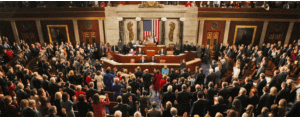 To reach the right decision makers with the right message, politicians should to take a page out of the B2B marketing playbook.
To reach the right decision makers with the right message, politicians should to take a page out of the B2B marketing playbook.
Unless you’re actually in the White House, most of us have little insight into the inner workings of the federal government and what politicians are up against. But you don’t need to be a senator or a lobbyist on K Street in Washington, D.C. to understand politics is a people business. Accomplishing meaningful policy changes demands solid relationships and trust. To activate true change, politicians must market their ideas and initiatives to constituents and other decision-makers in government who need to “buy-in,” just as business buyers do when considering a major technology purchase.
Here are three marketing strategies that can be just as effective for politicians chasing ambitious agendas as they are for B2B marketers chasing buyers.
- Build trust in key relationships
Committees drive B2B buying decisions. While B2B impulse buys are virtually unheard of, emotion still plays a role. How can buyers trust you have their best interests at heart? They need to know you’re about more than a payday.
B2B marketers know this and will take their time building trust with key customers by developing personalized experiences and engaging in meaning conversations that go beyond their product or service. This shows marketers are listening instead of selling. The difference is crucial: Listening shows empathy and a willingness to serve customers’ individual needs. In marketing, we know B2B buyers must trust your ability to serve their needs before considering your product. This trust is built over time through a number of positive experiences with your brand, but it can be lost in a matter of seconds if marketers don’t deliver on their promises.
The government takeaway: Every politician faces this same set of challenges when “selling” their initiatives to key constituents. Trust is the most basic requirement, which is often built by meeting constituents face to face and really listening to them. But as a federal official, how do you make time for that? It’s not as scalable for federal officials to meet a mass number of constituents as it is for local representatives to meet a much smaller number of local constituents.
Instead, similar to what B2B marketers do, federal leaders should focus on creating trust online by cultivating two-way dialogue with constituents through social media channels and online communities. It’s a more effective—and scalable—approach. But to create and maintain trust online, you must be transparent about how, and when, you’ll deliver on your promises. Thanks to the inherently open nature of the Internet, constituents will always remind you of those promises if you don’t follow through. And you’ll quickly lose the trust you earned.
- Break down all the silos
Think about the last time you called a helpline. How often did the service rep you talked to transfer you to someone else, only to have you repeat the problem you called about in the first place? When B2B companies treat their customers this way, it’s often due to silos between departments such as marketing, sales, support, finance, and more.
When these silos exist, they create another common scenario: when sales reps pitch a new product feature to customers only to learn from the support team frustrated users are calling because the feature doesn’t work as advertised.
Every one of these walls prevents healthy communication from flowing throughout the business and can quickly lead to negative perceptions of your brand. This happens far more often than many would like to admit, but in B2B marketing, we understand you have to act quickly on this knowledge and break down the silos to maintain trust and improve results.
The government takeaway: Today’s world of extremely polarized politics and few Congressional accomplishments demonstrates the need for federal agencies to collaborate more effectively. In some cases, agencies focused on similar goals could combine to better serve the nation, while in other cases a void could be filled. Such was the case after Sept. 11, 2001, when then-President George W. Bush created the Office of Homeland Security to ensure the nation’s military and intelligence agencies worked together more seamlessly. This type of collaboration will not only help the government provide more quality service, but will also create a better experience for constituents who often perceive federal agencies as inefficient and ineffective. By putting constituents’ needs first and making tough decisions as you break down silos, you can begin to improve the perception of government agencies and more successfully drive your initiatives.
- Don’t spread the message too far and wide
Mass awareness drives consumer brands. From TV ads to guerrilla marketing campaigns, it’s crucial for consumer brands to find their way into the minds of buyers. B2B marketing doesn’t work that way. No matter what B2B industry you’re in, it’s a naturally limited market, and there are typically a finite number of accounts that fit your target profile. The only way to reach them is to understand their needs backwards and forwards — and then create personalized experiences for them at every touchpoint to help build brand affinity. Because in a limited market, customers pay attention to not only what they’re buying, but who they’re buying from.
The government takeaway: At first glance, politics may seem like a consumer-marketing exercise, but politicians will have more success driving their agendas if they apply the rules of account-based marketing in B2B when dealing with colleagues in rival branches of government: listen carefully, know your audience, speak to a specific need, and keep interactions personal. While the executive branch must tailor its message across the entire country, Congress and other governmental leaders must nurture relationships from within the White House to build consensus. And they need to know whom to go to at the right moment with the right message.
As legendary Speaker of the House Tip O’Neill would say: “all politics are local.” So is all B2B marketing. Those that recognize this can change their fortunes — or, in the case of the federal government, the country. Those who don’t risk being left in history’s dustbin.
Sanjay Castelino is vice president of marketing at Spiceworks.
Related Articles:
B2B Connect to Convert: Lead Gen, Brand Buzz, An Eclipse & More
B2B Marketing Automation All-Stars: Special Report
What Are the Biggest B2B Pain Points?



